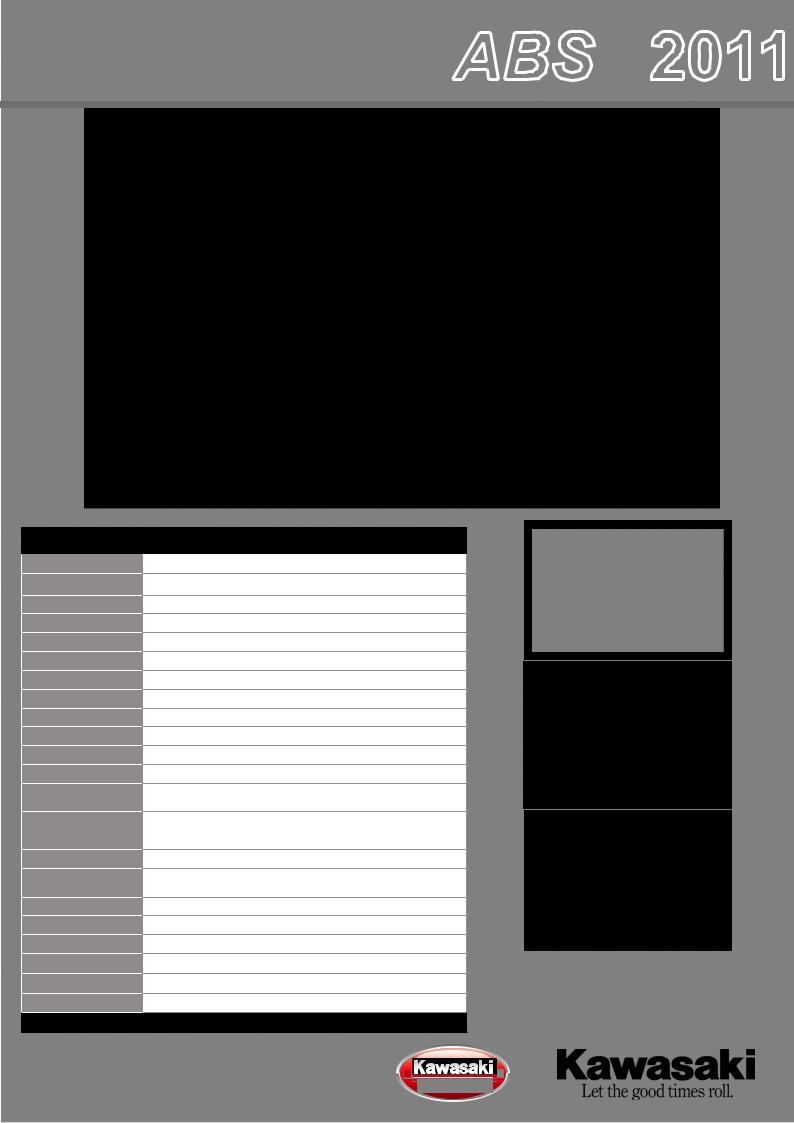Kawasaki 1400GTR ABS Manual

 ABS 2011
ABS 2011
Specifications:
ZG1400CBF
Engine Type
Displacement
Bore & Stroke
Compression Ratio
Fuel System
Ignition
Transmission
Rake/Trail
Front Wheel Travel
Rear Wheel Travel
Front Tire Size
Rear Tire Size
Front Suspension
Rear Suspension
Wheelbase
Front Brake
Rear Brake
Fuel Tank Capacity
Ground Clearance
Seat Height
Curb Mass (no panniers)
Colours x 2
Inline 4-Cylinder, 4-Stroke, Liquid-Cooled, DOHC 16 valve with VVT
1,352 cm³
84.0 x 61.0 mm
10.7:1
Electronic Fuel Injection, 40 mm x 4
Digital Electronic Fuel Injection
6-Speed
26.1°/ 112 mm
113 mm
136 mm
120/70ZR-17
190/50ZR-17
43 mm inverted fork with adjustable rebound damping and spring preload
Bottom-Link UNI - TRAK, Tera-Lever system with gas charged shock, remote stepless adjustable spring preload and rebound damping adustment
1,415 mm
Dual 310 mm semi-floating petal discs, radial-mounted Opposed 4-Piston callipers with K-ACT II ABS
270 mm single petal disc with Opposed Piston calliper with K-ACT II ABS
22.0 litres
125 mm
815 mm
304 kg (Includes full fuel tank and all fluids at correct levels)
Ebony (H8) or Metallic Dark Green (727)
Key Features:
1,352 cm³, DOHC with Variable Valve Timing
Kawasaki Traction Control (KRTC)
Kawasaki Advanced Coactive-braking
Technology (K-ACT) ABS
(Specifications subject to change without notice.)

2011 1400GTR ABS
TRANSCONTINENTAL SUPERSPORT: EVOLUTION
Building on the continent-crossing performance of its predecessor, the 1400GTR incorporates the latest touring features and rider support technology.
Delivering both awesome supersport performance and comfortable long-distance touring potential, the GTR stands apart from its rivals.
ADVANCED RIDER SUPPORT TECHNOLOGY KTRC (Kawasaki Traction Control) Kawasaki’s first traction control system
- Reduces engine output when wheel spin is detected, allowing the rear tyre to regain grip
- Enables rough roads to be traversed smoothly - Ensures grip is maintained on slippery surfaces
2nd Generation K-ACT (Kawasaki Advanced Coactive-braking Technology) ABS
K-ACT ABS complements rider active brake control with supplementary brake force enahancement for confident, highly effective braking in all situations.
Economical Riding Indicator
- Lets the rider know when fuel consumption is favourable
Fuel Economy Assistance Mode
- Selectable mode that switches to a leaner fuel map prioritising fuel efficiency
HIGH COMFORT & TOURING POTENTIAL
Large windscreen
- Electrically adjustable; new programmable preset positions
High mirrors
- Positioned 40 mm higher for increased rear visibility
Hand Grip Warmers
Stepless adjustable grip warmers are fitted standard. Switch is located close to the rider for easy access.
Stylish Bodywork
The shape and design of thebodywork provides great comfort.
Lockable Storage Case
Relocating the handy storage case from the top of the tank to the left side allows it to be accessed when a tank bag is being used.
Engine
* Ninja ZX-14 based engine tuned for more low end torque and mid range power.
*First model in class with Variable Valve Timing (VVT).
*VVT delivers high torque at low to medium engine speeds with ample power at higher engine speeds.
*The VVT unit is mounted on the intake camshaft and advances or retards the camshaft timing as engine demand changes.
*Gear-driven duel secondary balancers cut vibration minimising engine wear, noise and rider fatigue.
FUEL SYSTEM
*Electronic fuel injection feeds the engine exactly the right amount of fuel giving excellent power, fuel economy, low exhaust emissions, smooth driveability and easy starting.
*Compared to the Ninja ZX-14 the diameter of the throttle valves are reduced for more linear low and mid-range throttle response and driveability.
*Because the smaller diameter throttle bodies give increased intake velocity, throttle response is very crisp from low to high-engine speeds.
*High atomising injectors are used to maximise combustion efficiency and minimise emissions.
*Dual throttle valves are fitted to significantly improve driveability. The sub throttle valves are controlled by the ECU to provide precise response.
*The ram air induction system takes cooler, high-pressure air from in front of the cowling and pushes it through the air cleaner and into the engine for maximum power output.
EXHAUST SYSTEM
*To minmise emissions, a honeycomb catalyser is used.
*The internal construction of the muffler is unchanged from the previous model, however the end cap reduces the length by 40 mm for a more compact appearance.
ECONOMICAL RIDING INDICATOR
* The Economical Riding Indicator appears on the LCD screen to indicate favourable fuel consumption. Paying attention to conditions that result in the inidicator appearing can assist riders to maximise their fuel efficiency. This handy feature is active all the time.

FUEL ECONOMY ASSISTANCE MODE
* Fuel Economy Assistance Mode can be turned on and off by the rider. Turning on this mode on switches the ECU to a leaner fuel map that prioritises fuel economy over driveability. (Ignition timing and fuel injection are set for maximum fuel efficiency.) When on, the indicator appears on the LCD screen.
*Fuel Economy Assistance Mode is turned on and off by holding down the new Mode-Select button on the front of the left grip (where the passing button used to be).
*For either the Economical Riding Indicator or Fuel Economy Assistance Mode to be effective, the rider must ride in a gentle manner: less than 6,000 rpm, less than 30% throttle, under 160 km/h. Both Fuel Economy features work in any gear.
KAWASAKI TRACTION CONTROL (KTRC)
*Kawasaki’s first traction control system was designed, not to help riders go faster, but rather to provide rider reassurance by facilitating smooth riding on slippery surfaces.
*The system looks for difference in front and rear wheel speed. When rear wheel spin (i.e. when rear wheel speed is faster than front wheel speed) is detected, engine output is controlled to allow the rear wheel to regain grip.
*KTRC effectively enables riders to negotiate both short slippery patches (such as train tracks or manhole covers) and extended stretches of bad road (e.g. dirt, gravel, cobblestone, grass) without worry. Wheel spin is also limited when starting on a slippery surface.
*Additionally, because slower front wheel speed is interpreted as rear wheel spin, the system prevents wheelies. However, should the rear wheel lock up under engine braking (slower rear wheel speed), the system will not engage, nor is the system designed to prevent lateral slides – although limiting rear wheel spin may reduce the chance of a lateral rear wheel slide occurring.
*KTRC uses 3-way control, governing ignition timing, fuel delivery and airflow (via the sub-throttles). It is the control of the sub-throttles that enables KTRC’s smooth operation.
* By default, KTRC is always ON when the engine is started.
* Riders must consciously turn the system off (using the on/off button on the left grip). Turning KTRC off will cause the KTRC lamp to come on, letting the rider know the system is no-longer standing-by.
TRANSMISSION
*The 1400GTR comes equipped with a 6-speed transmission.
*The sixth gear is an overdrive gear that allows engine speed to be reduced when cruising for high comfort and low fuel consumption.
*Hydraulic operated clutch with radial mounted clutch master cylinder provides a smooth clutch operation and a high-class appearance.
*Adjustable back-torque limiter “slipper” clutch helps prevent rear wheel hop when down-shifting.
SHAFT DRIVE
* The GTR uses Kawasaki’s Tetra-Lever rear suspension system to almost completely eliminate the up/down movement associated with shaft drives during acceleration and deceleration, resulting in a very natural ride feel similar to chain drive with the added benefits of a shaft drive system (see rear suspension for more detail).
CHASSIS
The aluminium monocoque frame is a more advanced version of those used on the Ninja ZX-12R and Ninja ZX-14.
